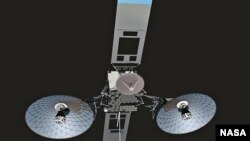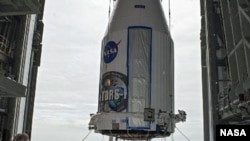If you've ever marveled at the Hubble Space Telescope's colorful images of the cosmos or watched video of astronauts in near-real time as they float through their lab on the ISS, you have a fleet of satellites to thank.
Space Network
The satellites comprise NASA's so-called 'Space Network,' formally known as the Tracking and Data Relay Satellite System, or TDRS.
Badri Younes, NASA's deputy associate administrator of Space Communications and Navigation, or SCaN, says science as we know it - and NASA as we know it - would not exist without such satellites.
"All of the beautiful images, whether you are looking deep into space trying to discover the origin of the universe, looking at the galaxies or looking at Earth trying to see the trend in the weather and the changes that are taking place," come from voice, video and data that people receive through SCaN, Younes told reporters at a pre-launch briefing.
The Space Network is an aging fleet that orbits the Earth, and it's about to get an upgrade with its first new spacecraft since 2002.
Upgrade
The U.S. space agency is preparing to launch the first of a new generation of communications satellites to link control centers here on Earth with NASA spacecraft, including the International Space Station. The satellite, called TDRS-K, is scheduled to launch aboard an Atlas V rocket from Cape Canaveral in Florida Wednesday night.
It will join seven surviving satellites in the TDRS set. Two have been retired, boosted about 400 kilometers higher into so-called "disposal orbit." One is in storage in orbit. Two more will follow TDRS-K.
The new satellite was designed for a lifespan of 15 years, but it could last much longer.
Legacies and the Future
NASA says the first of these satellites, launched 30 years ago, was used to support the first telemedicine surgery at the South Pole. That was when doctors in the northeastern U.S. state of Massachusetts were able to assist a physician in repairing the knee of a meteorologist in Antarctica back in 2002.
"Launch is just the beginning of this satellite's journey and the addition of TDRS-K to the overall constellation will continue the successful legacy of the project and strengthen NASA's communication system that is so vital for the International Space Station and many other satellites that are in orbit today and will be in orbit in the future," said Vernon Thorp, who handles NASA missions at rocket-supplier United Launch Alliance.
Thorp added that the TDRS constellation even helps scientists improve upon the very rockets that launch these satellites into orbit.
Space Network
The satellites comprise NASA's so-called 'Space Network,' formally known as the Tracking and Data Relay Satellite System, or TDRS.
Badri Younes, NASA's deputy associate administrator of Space Communications and Navigation, or SCaN, says science as we know it - and NASA as we know it - would not exist without such satellites.
"All of the beautiful images, whether you are looking deep into space trying to discover the origin of the universe, looking at the galaxies or looking at Earth trying to see the trend in the weather and the changes that are taking place," come from voice, video and data that people receive through SCaN, Younes told reporters at a pre-launch briefing.
The Space Network is an aging fleet that orbits the Earth, and it's about to get an upgrade with its first new spacecraft since 2002.
Upgrade
The U.S. space agency is preparing to launch the first of a new generation of communications satellites to link control centers here on Earth with NASA spacecraft, including the International Space Station. The satellite, called TDRS-K, is scheduled to launch aboard an Atlas V rocket from Cape Canaveral in Florida Wednesday night.
It will join seven surviving satellites in the TDRS set. Two have been retired, boosted about 400 kilometers higher into so-called "disposal orbit." One is in storage in orbit. Two more will follow TDRS-K.
The new satellite was designed for a lifespan of 15 years, but it could last much longer.
Legacies and the Future
NASA says the first of these satellites, launched 30 years ago, was used to support the first telemedicine surgery at the South Pole. That was when doctors in the northeastern U.S. state of Massachusetts were able to assist a physician in repairing the knee of a meteorologist in Antarctica back in 2002.
"Launch is just the beginning of this satellite's journey and the addition of TDRS-K to the overall constellation will continue the successful legacy of the project and strengthen NASA's communication system that is so vital for the International Space Station and many other satellites that are in orbit today and will be in orbit in the future," said Vernon Thorp, who handles NASA missions at rocket-supplier United Launch Alliance.
Thorp added that the TDRS constellation even helps scientists improve upon the very rockets that launch these satellites into orbit.







